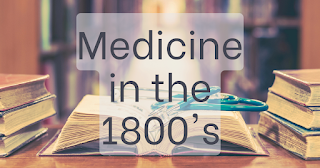By Kristy McCaffrey
Doctors who practiced in the 19th century were
generally followers of Benjamin Rush. He was a well-known physician in the 18th
century who graduated from what would later become Princeton University at age
14. A brilliant and devoted practitioner who cared deeply for his patients, he
nevertheless championed the principle of extreme purging and bloodletting. He
believed all diseases were due to a morbid excitement induced by capillary
tension, and the counteraction of treatment and outcome became termed as “allopathic”
(cure by opposites). A smaller group of doctors were known as homeopaths and
eclectics, but they were far fewer in number.
In the 19th century physicians were generally held in low
esteem, but between 1890 and 1910 there were impressive scientific advances.
They included practical methods to measure blood pressure and temperature,
standardized eye tests, electrocardiograms and x-rays, chemical and
bacteriological tests, diphtheria antitoxin, vaccines for rabies and typhoid,
the Wasserman test (a test for syphilis antibodies), and the drug Salvarsan (also
known as compound 606) for the treatment of syphilis. These developments greatly
advanced the practice of medicine along with the standing of physicians, which
reached its peak in the 1920s.
The American Medical Association (AMA) was established in
Philadelphia in 1847 in response to widespread medical quackery, the
unregulation of medical schools, and the unreliability of medical journals. The
AMA reached its power between the periods of 1890 to 1920. It had a Council on
Pharmacy and Chemistry, which regulated the pharmaceutical industry. It had a
section for New and Official Remedies. The AMA also changed the focus of
advertising. Earlier, companies advertised directly to the public. The AMA was
able to stamp that out, allowing only advertising directly to physicians. The
Council on Medical Education had the force of law, and the state licensing
boards followed what the AMA wanted. The result was steadily rising standards.
Oklahoma Territory
November 1899
Dr. Anna Ryan has been spurned by the Dallas medical community for the simple reason of being a woman. Wanting more than a rural practice alongside her mother, also a doctor, Anna accepts an invitation from a mentor to join a private hospital for disabled children in Oklahoma City. But when she falls in with a band of women attempting to liberate a town of innocents, she’ll need more than her medical training to survive.
Malcolm Hardy has skirted the line between lawlessness and justice since escaping the mean streak of his father and his no-good half-siblings a decade ago. In Oklahoma Territory he created enough distance from his family name to find a quiet purpose to his days. But then Anna Ryan walks back into his life, and his hard-won peace is in jeopardy.
The last time Malcolm saw Anna, she had been a determined girl he couldn’t help but admire. Now she was a compelling woman who needed his help to find The Swan, a mysterious figure with a questionable reputation. But one thing was clear—Anna’s life path was on a trajectory for the remarkable while Malcolm’s was not. Surrendering to temptation would only end in heartbreak.
Anna is the eldest daughter of Logan and Claire from THE DOVE.
The Wings of the West Series Reading Order
Book One: The Wren
Book Two: The Dove
Book Three: The Sparrow
Book Four: The Blackbird
Book Five: The Bluebird
Book Six: The Songbird (Novella)
Book Seven: Echo of the Plains (Short Story)
Book Eight: The Starling
Book Nine: The Canary
Book Ten: The Nighthawk
Book Eleven: The Swan (Coming Soon)
Connect with Kristy
Website | Facebook | Instagram | TikTok | Newsletter




.jpg)

4 comments:
Medicine and science sure as come a long. Still, whether back then or now, I'd never make it past the 1st day of med school. I'm just not cut out for that.
It certainly makes you appreciate the level of care we have today.
Some very useful info here, thank you. And what captivating titles on you books!
Thanks so much, Gini!
Post a Comment